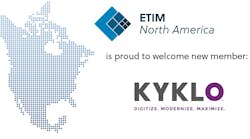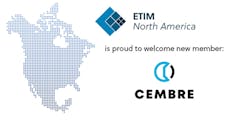The data synchronization efforts to drive out costs and capture efficiencies throughout the electrical industry's marketing channels have made it a touchstone for other industries. The progress made by IDEA, Arlington, Va., and the various associations and other entities involved have begun to return benefits for many distributors and manufacturers.
To date, though, the progress, the discussions and the work have all been focused on the transfer of data between manufacturers and distributors. Very little attention has been paid to the benefits synchronized data could provide downstream from the distributors — to their interaction with their customers.
The reasons for this are clear and sensible. The most important first step is getting the data quality and format right at the source — the manufacturer — and until that connection between manufacturer and distributor works, there's not much benefit that can flow downstream.
IDEA's charter is to synchronize data at the manufacturer-distributor level, but Bob Gaylord, president of IDEA, who is leading a strategic review of IDEA's direction, is also cognizant of the needs of the channel as a whole.
“A lot of people are looking at that downstream relationship with contractors. I don't believe we've got the relationship between distributors and manufacturers perfected yet, and we're not going to take our eye off the bubble on that relationship,” Gaylord says. “But at the end of day, if you're not focused on the ultimate customer, everybody suffers. If we're not driving cost out of the channel, that cost will be borne by the ultimate customer.”
The fact remains, until the whole industry is able to benefit, unneeded costs will remain in the channel. A couple of companies have started the ball rolling on the downstream end, attacking one of the (many) pockets of antiquated busy work that still must be done for distributors and contractors to exchange information. They're providing systems that allow contractors to access their negotiated distributor pricing with the click of a button from within their estimating software systems.
This is an attempt to replace the time-honored process in which the contractor prints out the bill of materials for a job he wants to bid on, faxes it to his distributor, a distributor inside salesperson then looks up the prices, fills out the list, faxes it back, and the contractor completes his bid. Even in the more sophisticated exchanges, the contractor exports the data in a spreadsheet, sends it to the distributor, the distributor populates the price columns and e-mails it back.
About five years ago, ElectricSmarts.com, a multi-media marketing and training company, recognized the glint of opportunity to alleviate the grind of this process by automating the bid-pricing process. They rolled out NetPricer as a separate company.
“We thought, wouldn't it be terrific if the contractor could get his pricing from a blanket agreement with his supplier at the beginning of the year and get that pricing to percolate into his system?” says Keith Peck, president of ElectricSmarts.com and NetPricer. “ElectricSmarts was already doing a lot of work with Internet content, syndication of marketing information. We had the technology and the capabilities to do it. So, we created a web service to sit in middle between the distributor and contractor's estimating package.
NetPricer worked with the many vendors of contractor estimating software to create a one-click solution that would allow contractors to populate the price columns of their estimates from a network server with their specific pricing supplied by participating distributors.
The territory they were entering wasn't entirely uncharted. Trade Service Systems, a software firm now owned by Activant Solutions, had developed a similar service called TradePower years before, but ran into resistance from distributors concerned that the service would make it entirely too easy for customers to price-shop multiple distributors on each bid.
NetPricer ran into the same concerns and found ways to overcome them, says Peck. “Some distributors were concerned it would be an easy way for their customers to cherry-pick the lowest prices. We've found that most of the contractors only connect to one to three distributors on average, distributors who they have the best relationships with. They're not using it to bat down prices. Distributors have recognized how efficient it is for them and for the contractors. They went from something that could take hours to something that takes five seconds. And they can do it 24/7 without any people involved.”
Now comes Trade Service Corp., San Diego, (once the parent company of Trade Service Systems) into the market with a new service, Supplier Xchange, to address the same issue. Supplier Xchange, preparing to launch in July, is the first step in a new offering called Trade Service Online (TSO) that will roll out in a larger way later in the year.
Trade Service is starting with the installed base of 6,000 electrical contractors who already use its TRA-SER product and pricing database and distributors who subscribe to the Trade Service data system. It's also starting with a sales force that includes Stacey Pandeloglou, a veteran of the industry's technological side who led the original Trade Power team while at Trade Service, and now has an innovative independent rep agency called Distribution Technology Group, Virginia Beach, Va., devoted to technology companies. Trade Service is his “anchor tenant.”
Trade Service confronted distributors' concerns about facilitating contractor price-shopping by including several ways for the Supplier Xchange system to keep distributors in the loop. The idea is to use the system to build and strengthen relationships, says John Henry, director of business development for Trade Service.
When a contractor pulls down pricing to prepare a quote, Supplier Xchange sends a notice to the distributor telling the project name, the pricing provided, where the products matched and where they didn't. This gives the distributor a live lead and a perfect reason to pick up the phone and call the contractor.
“When we talk to a distributor about this, the distributor understands this is a service to meet a real contractor need,” says Bob Stone, director of sales and business development for Trade Service. “They said, ‘I don't want this to replace my systems for engaging with my contractor customers and providing the level of service my company is known for.’ They had a fear of being cut out of the loop. In Supplier Xchange, when a file is transferred, an automatic message goes to the distributor, telling him this contractor requested and received pricing for these items, these matched up, these didn't, and it give him a list. The distributor can then engage that customer in a way that differentiates him from his competition. He can call him up and say, ‘Glad to see we matched up, what else can I do to help you?’”
NetPricer handles the same issue by providing distributors with an administrative area on the server where they an go in and look at the bids contractors have prepared using their pricing, so that they can follow up, Peck says. Distributors can also set the system to forward an e-mail to a salesperson or branch manager when a contractor accesses the distributor's pricing to assemble a bid.
A big challenge both services had to overcome was the inevitability that some of the products the contractor enters in the estimating system for the bid don't match those carried by the distributor. Addressing this required building cross-reference databases at several levels to match generic product names with brand name products and each branded product with viable substitutes from competing manufacturers.
Trade Service, whose core service in the electrical industry for generations has been to provide product and pricing data — originally in bound volumes and now through electronic products such as TRA-SER — already had its system in place.
“Trade Service, that's what they are. Data content,” says Pandeloglou. “They cross-match each estimating system a contractor uses. (All the estimating packages) have a seed database and each of them is different from the next. The first thing we did was match that seed database to our database. Then we have two types of cross-match databases — a generic-to-branded database, and one level higher to match branded items a supplier carries, and then the Comparator database that assigns substitutes.”
Henry adds, “We even have a staff of domain experts ready to manually match those items that cannot easily be cross-referenced electronically. We expect going this extra mile will be a key differentiator for us.”
NetPricer assembled a team of people with electrical industry experience and built its own database from scratch, says Peck. “There's a lot of manpower devoted to building and maintaining that database. You have to go through the whole industry line item-by-line item. The other challenge there, is that with commodities you may have a different quality of data. For example, for pipe and wire, rather than having six manufacturers in the system, distributors may have made up their own code so they can buy from anyone they choose.? When they upload the pricing file, we may have to have people who know the market go through the data and identify and cross-reference this made-up information to actual manufacturers.”
Another reason the original Trade Power project ran aground was due to the service's pricing, says Pandeloglou. “The model that TradePower had used was a transaction model based on the number of transactions. The plan was to make a lot of money off transactions between contractors and distributors. That's a major difference.”
In contrast, Trade Service is providing Supplier Xchange to its TRA-SER subscribers free of charge. “The reason it's free is not because we're a charity,” says Stone. “Contractors tend to be fickle in the way they subscribe to TRA-SER. When times get lean, they tend to cancel their subscription, then six months later they pick it up again. That's not the way we wish it would work. If through Supplier Xchange we can provide a service that's useful to them all the time, it might moderate that in-one-day-and-out-the-other cycle. It's largely a retention strategy for TRA-SER and also a way to generate new sales.”
Contractors have readily embraced the ability to get their distributor pricing automatically loaded in their bids, Peck says. Whether that could lead them to seek more access to product data and even move into electronic data transactions remains to be seen. Peck suspects a generational change may tip the balance.
“Younger contractors are more computer savvy,” Peck says. “The young guy sees the efficiencies computers can bring to the game. The older contractors have to be pulled into it. It's not something they're asking for. I don't know why that's the case.”
To be sure, providing contractors with automated pricing from their distributors just barely scratches the surface of what could be done — and the benefits that could be gained — if distributors and contractors were able to transmit all their transaction data, including purchase orders, invoices, etc., electronically in a standardized format.
The reason the industry hasn't been concentrating on pushing data synchronization down to the contractor level may simply be that contractors haven't asked for it. The way it's always been done still basically works. But if these systems for providing automated company-specific pricing become a competitive advantage by making the bid-pricing process more efficient, it's reasonable to expect more contractors to get interested.
To the industry as a whole, it may not matter so much which system wins in this faceoff between NetPricer and Supplier Xchange. The greater good may be served by the fact that they're going at it. The healthy competition to see who can provide the best package of product data, pricing and information services to electrical contractors may be enough to seed a greater awareness of the power of synchronizing data in the contractor end of the electrical channel. If this doesn't do it, a generational change just might tip the balance.








